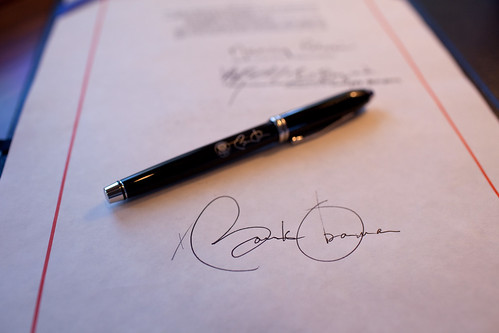What does our prime minister’s handwriting say about the man?
Who would have guessed our prime minister penned such beautiful cursive
Prime Minister Stephen Harper note is shown in a book of condolence at the British High Commission in Ottawa, Tuesday April 9, 2013, in honour of Margaret Thatcher the former British prime minister who passed away Monday. THE CANADIAN PRESS/Fred Chartrand
Share

Rarely is our prime minister an elegant man. Then again, rarely do we see his handwriting.
When he signed the book of condolences for the late Margaret Thatcher at Ottawa’s British High Commission, Stephen Harper penned a four-line message—capped with his signature, which we see now and again—that was effusive in praise of the Iron Lady:
Canada deeply mourns the passing of Margaret Thatcher, a great friend of our country. Hers was a leadership example for the ages, from which we all benefit to this day – and will for many more to come.
Harper’s penmanship represents the opposite of the way he’s come to be defined: the cursive is elegant, and warm; the lettering is intricate; the message is a whisper, visually, bunched together between the lines. Harper’s first words appear timid, though he marked Thatcher’s name with a confident flourish. This is not the handwriting you expect from a man defined variously as controlling, as a bully, as cold.
As for his signature: We’ve seen this before, appended to various correspondence dating back years. Traces of that elegance pop out—check out the detail on the ‘H’—but it betrays little of Harper’s careful penmanship.
Handwriting, critiqued

Remember Jack Lew’s appointment as U.S. treasury secretary, earlier this year? Lew, who’d served as President Barack Obama’s chief of staff for a year prior to his current post, was ridiculed by the president and the press in January for a signature that’s a little loopy—actually, a whole lot of loopy. The treasury secretary’s signature appears on American currency, and Obama joked that Lew assured him he’d “work to make at least one letter legible in order not to debase our currency.”
And then there was disgraced former congressman Anthony Weiner, whose minimalist signature turned some heads in 2011 and had the Village Voice wondering what it all meant—and quoting purported experts saying that Weiner’s signature featured “typical traits of a master politician.”

Even the signatures of would-be political leaders—say, candidates for the Republican presidential nomination—couldn’t escape the critiques of graphologists. Sheila Kurtz, one such graphologist, took a look at U.S. President Barack Obama’s handwriting. She wrote that his penmanship suggests he is “extremely nimble-minded” and “unclogged with preconceptions.” He “thinks before taking action,” wrestles with “surges of impatience”, and maintains a “full imagination with a literary bent.” Finally, because his upper loops are “very full,” Kurtz says Obama is probably a spiritual person.